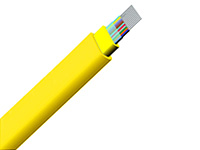Optimize Network Capacity with Ribbon Fiber Cable
Since the transmission protocols progress to higher and higher data rates, local area network (LAN) campus, building backbones and data centers are expected to employ cables with greater fiber counts, aiming to meet the accelerating system bandwidth needs. Ribbon fiber cable on account of their high coupling fiber optic cable capabilities becomes an ideal tool for data centers as well as limited indoor environment. Then what is ribbon fiber optic cable? Why it has an important influence on optimizing network capacity? Read this ribbon fiber wiki for more info.
Ribbon Fiber Overview
Usually, a ribbon fiber cable consists of individual fibers aligned in a single row on the same flat plane, which explains its name “ribbon fiber cable” or “flat ribbon cable”. Each ribbon can have between 4 and 24 fibers. With this special cable structure, ribbon fiber cables enable mass-fusion splicing, with 12 fibers spliced in a single procedure for easier fiber management, faster network builds and quicker restoration following fiber cable cuts. To optimize the fiber packing density within the ribbons fiber cables, multiple individual ribbon optical fiber cables can be stacked into a bundle with a matrix structure and stored in a central core-tube or stranded multi-tubes in the cable core. According to the market report, the corning ribbon fiber cables are available in up to 1728 fiber counts. And OFS ribbon fiber cables are available with 1728 and 3456 fibers in a single cable.

Ribbon fiber cables have an array of color coded fibers configured as fiber ribbons housed in loose tubes or in larger central tubes. To achieve better cable management, each fiber should be uniquely color coded according to fiber cable color code standards. Ribbon fiber color code is based on the preferred method—blue, orange, green, brown, slate, white, red, black, yellow, violet, rose, and aqua. In some situations, when the fiber counts are the multiple of 12, the color will also be multiple. Know more details about ribbon fiber color code here: How to Identify the Fiber Optic Cable Color Code?
Ribbon Fiber Cable vs Loose Tube Optical Cable
Why ribbon optical fiber cables are getting popular in fiber optic cabling? What’re the advantages of ribbon fiber cables? Here are the reasons.

Loose tube optical cables are often deployed for outside plant trunks, because they can provide exceptional and reliable protection for fibers under high pulling tensions. The most obvious advantage of ribbon optical fiber cable is its high fiber density. Therefore, ribbon fiber cable vs loose tube fiber cable, there are main five advantages.
Ribbon Fiber Cable Applications
Aerial/Under Ground Outside Fiber Plant
Cables for outdoor applications are required to withstand more harsh conditions seen outside, from environmental extremes to mechanical forces. Here take under ground cable plant for example. Cables are usually installed in a conduit which has several innerducts for pulling cables. Cables here need to bear high pulling tension. Ribbon fiber cables can be long and straight, any pulling or bends are gradual along large diameters, so the risk of non-preferential damage is very small, making it a better solution for aerial or under ground fiber plant.
Deployment for LAN and Data Centers
Local area network (LAN) campus and building backbones as well as data center backbones is migrating to higher cabled fiber counts to meet increasing system bandwidth needs. Among the various fiber counts with ribbon optical cable, the 12-fiber ribbons are the most commonly and widely used ones. The following are the main deployment of flat ribbon fiber cables in data center and LAN building networks.
In addition, ribbon fiber optic cable is compatible with most fiber splice closures, cabinets, and pedestals used in the outside plant. And with different fiber counts, ribbon fiber optic cables can be deployed in various applications. For example, cables with 144 or 288 fibers are designed to provide high fiber density and speed installation when cabling a new data center or central office deployment.
FS.com Ribbon Fiber Cable Solution
FS.com offers different flat ribbon fiber cables for indoor cabling and access network applications. These cables are organized with 8-fiber or 12-fiber ribbons inside a central tube that is surrounded by dielectric strength members and a specially formulated flame-retardant outer jacket. The 8-fiber or 12-fiber ribbons have readily identifiable ribbon ID numbers and fiber colors that allow for easy access to individual fibers.
You might be interested in
Email Address

-
PoE vs PoE+ vs PoE++ Switch: How to Choose?
Mar 16, 2023
















